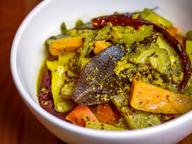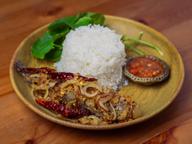halal
Braised yee mee
A perfect pantry-friendly template to use up your favourite vegetables and proteins.
Bubur pulut hitam (Black glutinous rice porridge)
A classic dessert eaten during confinement or simply when you crave tong sui.
Chicken in soy sauce (Ayam kicap)
A perfectly delicious chicken dish for those days when you really don’t have the energy to cook.
Beef peratal
This tender, aromatic semi-gravy dish is an excellent centrepiece for beef-eating Tamils during Tamil New Year and Ponggal.
Sambal tempoyak daun kayu
Thinly sliced daun kayu or cassava shoots cooked in tempoyak is a classic Negeri Sembilan dish.
Tempoyak ikan patin
Fermented durian gives this classic Pahang dish a rich taste and heady aroma.
Tempoyak
Make your own tempoyak with just durian flesh, salt, and time.
Deep-fried okra
Revive dry, stale okra by deep-frying it until crunchy and supremely snack-able.
Taucu fish
Salty and aromatic pantry ingredients marry in this savoury foil for plain starch.
Semomok sambal
A dry sambal that’s fragrantly delicious, perfect for eating endlessly with rice.
Kari kaja’ siyok (chicken feet curry)
A Dayak chicken curry made with an often-overlooked off-cut: chicken feet.
Chicken pineapple curry
We’ve been putting fruits in savoury dishes for ages in this part of the world, such as this chicken curry which gets a tangy boost from pineapple.
Huan chu heok masak lemak
A Nyonya classic that uses sweet potato and its leaves in one luxurious dish.
Chai poh tofu
Cold smooth tofu topped with crunchy aromatics makes for a quick lunch when you don’t want to turn on the stove.
Singgang
Make this singgang with extra soup to sip on slowly when you’re under the weather.
Fried macaroni
A classic party dish of many Malay families, this can be whipped up in more or less the time it takes to boil pasta.
Tebaloi (Coconut-sago crackers)
A perfect not-too-sweet snack to add to your array of CNY treats.
Mochai karuvadu kuzhambu (Field beans & salted fish curry)
A deeply savoury curry found in many South Indian and Ceylonese homes.
Indian-spiced tofu
Give tofu some extra love with a healthy dose of warm spices and plenty of complementary textures.
Coriander prata
How much coriander can you pack into one roti? Quite a bit, as it turns out.
Kueh teow soup
This noodle dish is one of the most versatile to have in your back pocket.
Pinarasakan sada bambangan (Braised fish with wild mango)
When bambangan season rolls around, this braised fish is a delicious way to use up a glut of the fruit’s harvest.
Kurat kasam dihan (Splitgill mushrooms with tempoyak)
There isn’t much that tempoyak can’t improve, and cooking it with mushrooms both complement and enhance the overall umami of both ingredients.
Sambal kicap
Sambals don’t need to be complicated. Just three ingredients can give you a soy sauce sambal so good, you’ll want for no other condiment.
‘Bitter’ porridge
This minimalist Lunbawang staple manages to be satiating and incredibly comforting without being heavy.
Onion-garlic oil
Adaptable for many different meals across many different cuisines, this onion-garlic oil is a condiment you’ll keep coming back to.
Yau mak with onion-garlic oil
The onion-garlic oil provides a lightning-fast way to get flavourful vegetables on the table for dinner.
Steamed fish with onion-garlic oil
Low-stakes steamed fish to get you accustomed to making this favourite at home.
Chicken with semomok & kulim
A Semai-style chicken braise full of flavour, suitable for your daily cooking repertoire.
Sambal goreng
While sambal goreng can easily feed a crowd during Raya festivities, it can also be made all year round as a clean-out-the-fridge treat.
Cashew chicken kurma
A mild, gently spiced curry thickened with cashews and fresh coconut.
Braised fish head with fuchuk
Using just a few pantry ingredients—aside from the fish head, of course—this speedy dish is quite simply what it says in its title.
Vangi bhath (Eggplant & lentil spiced rice)
A wholesome one-bowl meal for special occasions or just because, packed with flavourful spices and hefty vegetables.
Braised turmeric chicken
When you want ayam kunyit but can’t bear the oily cleanup, turn to this braise instead.
Tinned sardine puttanesca
Fried pasta makes for a quick weekday lunch in between work calls. Prep a large batch to bring to a party, and watch it disappear like magic.
Sardine sambal
Wonder why sardine sambal isn’t up your alley? Try this pre-frying technique and let us change your mind.
Simple tomato soup
Zhuzh up your everyday tomato soup with spices and raisins for a flavoursome lunch.
Black pepper meehoon
Fiery black pepper meets silky meehoon in this quick meal, perfect for when you want a homemade meal—fast.
Linugu tanggalung kinayan limau om bawing (Roasted eggplant with lemon basil salad)
A smoky eggplant salad to accompany a variety of meals, from rice to steaks, or as a part of an appetiser platter.
Vegetarian rice porridge
A rice porridge filled with savoury treasures, a centrepiece for any vegetarian feast.
Deep-fried tapioca
Quick, cheap, and filling, these tapioca chips are a fantastic treat for all ages.
Tapioca fritters
These savoury fritters are crispy, crunchy, and perfect for a late afternoon pick-me-up. Best served with chilli sauce.
Tapioca sambal tumis
This sambal tumis is the perfect hearty breakfast to sustain you the whole morning.
Kuih talam
Looking to get into kuih-making? Talam is an excellent beginner recipe to pick up essential kuih-making skills.
Jollof rice
This rice dish is beloved all across Nigeria and West Africa, full of tomatoes and heat.
Khanom jeen nam ya / Southern Thai fish curry with noodles
Plenty of coconut milk and freshly steamed fish make for a hearty bowl of fish curry noodles, perfect for a family dinner.
Fried popiah
Clear an afternoon to make a stack of these snacks for a party, kept as an emergency stash, or given to the neighbours.
Bosou sada
Ferment your fishing trip catch with this method, and enjoy a uniquely Kadazandusun flavour while you’re at it.
Pinongian sada
For those familiar with fermenting their own fish, try this Kadazandusun twist and add pangi or keluak to the mix.
Yellow chicken gulai
Chicken and coconut milk come together in a simple preparation of gulai kuning or masak lemak, perfect for a quick yet satisfying meal.
Sambal tempra
A base Eurasian sambal for many dishes such as prawn or ikan sambal, and sambal petai.
Aloo mutton keema
A versatile minced meat sauce that can be paired with your carb of choice for a complete meal or even a quick snack.
Terung Dayak with mackerel
This dish is a common staple on Diana’s family dining table, as her mom would buy terung Dayak whenever they were in season.
Banana heart kerabu
Rather than raw, this kerabu includes cooked elements that result in something like a masak lemak.
Fried bread
Stale pieces of Gardenia to use up? Whip up this quick, customisable snack and enjoy with a cup of tea.
Sweet mango chutney
Unlike many other chutneys popular in the Malaysian-Indian repertoire, this one veers sweet and makes for a great snack on its own.
Thai-style bihun salad
A wonderfully savoury salad for a crowd, perfect for potlucks, parties, and picnics.
Fried rendang
Soft and tender chunks of meat without hours on the stove is not possible, but getting those spicy rendang flavours definitely is.
Creamy spicy chicken curry
This version of Malaysian-Indian chicken curry uses store-bought curry powder such as Baba’s, but is taken up a notch with extra spices.
Pulut kacau
Pulut kacau or wajik can be made at home as a gift for the neighbourhood.
Acar hu
This Nyonya-style fish pickle ticks all the tasty flavour boxes: tangy, fatty, savoury, sweet.
Onion & ghee carbonara for one
No meat, no problem. This carbonara substitutes bacon fat with rich ghee, making it just as indulgent.
Sunquick soda
If you’re going to give yourself a sweet treat, go all out and bring some canned fruits to the party for a drink you can eat.
Vegan substitutes for a Malay kitchen
Daging kunyit without the daging? Ayam masak merah without the ayam? Yes, it can be done, and done deliciously.
Mom’s year-round yee sang
When joy is scarce, we find every reason to celebrate. Make this yee sang any time of the year.
Pumpkin masala
A subtly spiced and hearty side dish, unfussy enough for a weeknight.
Tomato mee for one
This recipe is based on Glenn’s favourite stall that he claims serves “the best version of tomato mee” that he has come across so far.
Sesame miso cookies
For these cookies, recipe developer Yi Jun combines miso and brown sugar to create soft, chewy morsels studded with sesame seeds.
Fried crackers for one
When fried like this, the cream crackers maintain their crunch while also absorbing the oil from the spice mix. Necessity really is the (grand)mother of invention.
Umbut sawit in belacan
Umbut sawit is the young shoot or heart of the oil palm tree. Plentiful in Borneo from the plantations, resourceful locals have found that it makes for a terrific ingredient.
Rich butter cake
This butter cake recipe comes from Dinesh Rao who founded Tray Cafe, which churns out some of the best butter cakes outside of a kopitiam.
Paeh ikan keli
The Temuan way to cook this fish is over the embers of an outdoor stove. We highly encourage you to go for it if you have a grill.
Ayam asam rong
This is a traditional recipe originating from Jerantut, Pahang, and has since spread to neighbouring areas in the state.
Can the Milo truck recipe be recreated at home?
One ardent Milo fan sets out to recreate the classic Milo truck drink at home. Contrary to Sports Day rules, second helpings are very much encouraged.
Gaeng som
This dish, inherited from Banyen’s late grandmother, makes an appearance at least twice a week on their dinner table at home.
Ponggal rice
Made with fresh rice of the first harvest at the end of the winter solstice, this is offered to gods & goddesses before family & friends.
Shukto
Leela’s late mother was the family’s ‘culinary comforter’, and taught her how to make this vegetable dish. Complex in flavour, this recipe takes no shortcuts.
Eurasian braised tongue
This recipe is adapted from Indonesian semur, which itself is an influence on smore, a common Eurasian dish in Malaysia and Singapore.
Horlicks flan
A dessert containing eggs, milk and Horlicks means it’s okay to eat for breakfast, right?
Pekasam ikan
Many kampung folks catch freshwater fish as a cheap source of protein, and pekasam is a way of fermenting a glut of a catch.
Granny’s chicken pongteh
The slow braise of ingredients in this pong teh coax out every bit of flavour—it’s worth splurging on good chicken and soy sauces.
Shallot prawns
Between the char of the crispy shallots, the umami of the soy sauce, and the sweetness of the prawns, one really doesn’t need anything else.
Kangkung belacan
This is quite possibly the best version of kangkung belacan we’ve tried—spicy, briny and still-crunchy.
Hinava tenggiri
Hinava is a traditional native dish of the Kadazandusun people in the state of Sabah, which is a method of cooking saltwater or freshwater fish using lime juice.
Fenugreek fish sambal
The star of this dish is fenugreek, along with the freshest fish possible.























































































